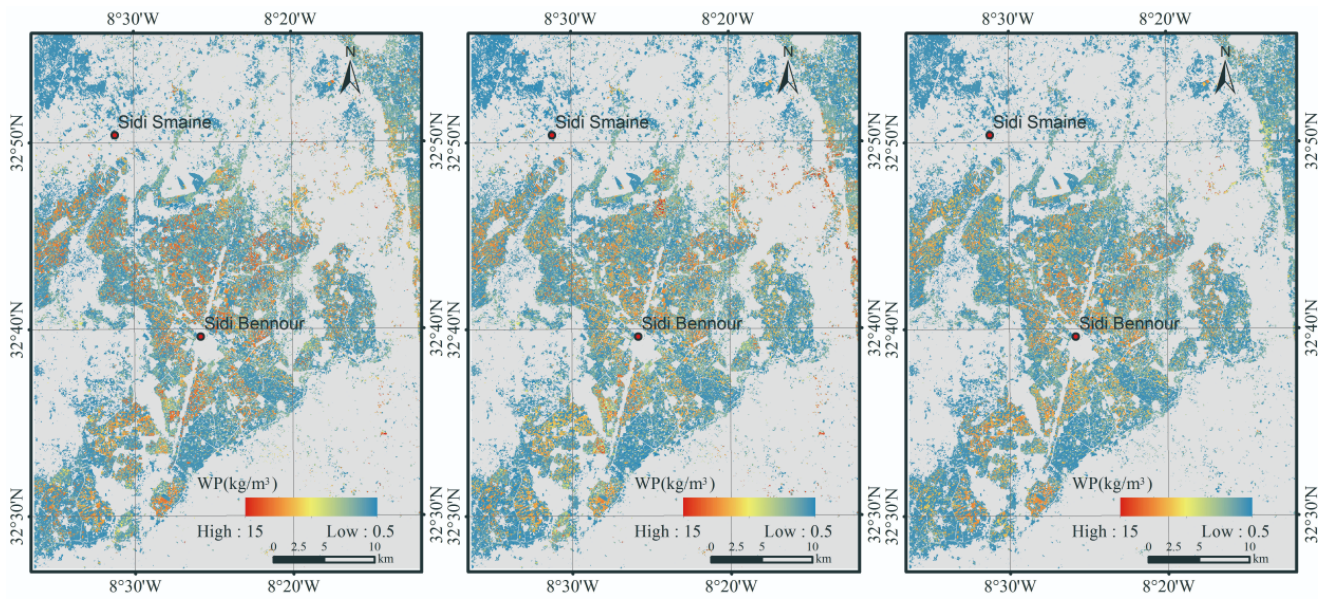SDG6: Clean Water and Sanitation
Crop water productivity for the SDG assessment of agricultural water use efficiency: case of a typical irrigation district in Morocco(2019)
Scale: Local
Study area: Sidi Bennour Irrigation District, Morocco
Many countries and regions along the Belt and Road are facing problems of uneven spatiotemporal distribution of water resources, water shortages, and over-exploitation of groundwater. Globally, agriculture water use occupies about 70% of freshwater withdrawal. Therefore, improving water use efficiency in agriculture, in particular in water scarce regions, is critical for ensuring the sustainable use of water resources and agricultural development. There are many ways to evaluate agricultural water use efficiency that relate to cultivation and irrigation practices and the level of irrigation water management. Water productivity is a widely used indicator that refers to the yield or converted economic value produced per unit volume of water consumed. Therefore, Crop Water Productivity (CWP) defines crop water use efficiency in terms of production and economic benefits.
Crop Water Productivity assessment using Big Earth Data can provide scientific support to optimal management of water resources and use for sustainable development, and can provide methods and data under the framework of SDGs.
A Big Earth Data-based crop water productivity assessment method was applied to the Sidi Bennour Irrigation District in Morocco to provide scientific and technological support for improving irrigation water productivity and agricultural water use efficiency. The study was conducted with the support of the DBAR International Center of Excellence in El Jadida.
Target 6.4: By 2030, substantially increase water use efficiency across all sectors and ensure sustainable withdrawals and supply of freshwater to address water scarcity and substantially reduce the number of people suffering from water scarcity.
Indicator 6.4.1: Change in water-use efficiency over time.
Method
Crop water productivity is measured as the ratio between crop yield and crop water consumption in the unit of kg per cubic meter (m3). This case presents assessment of crop water productivity based on the estimation of crop yield and crop water consumption (evapotranspiration) using Big Earth Data. The model was established upon theories of energy balance, water balance and plant physiology of a crop-soil system to estimate the transfer of water and carbon fluxes in different energy and water supply conditions. Meteorological conditions such as radiation flux, precipitation, wind speed, air temperature, humidity, pressure, and a variety of biophysical parameters retrieved from multi-source remote sensing data were used to drive the model.
Data used in the case
Multi-source satellite remote sensing data from Sentinel-2, Landsat 8, and MODIS were used to retrieve biophysical parameters including surface albedo, leaf area index, vegetation coverage, land surface temperature, soil moisture, land cover, and crop type classification. The fifth generation ECMWF Reanalysis (ERA5) data 一a global near-surface atmospheric reanalysis product released by the European Centre for MediumRange Weather Forecasts (ECMWF) —includes air temperature, dew point temperature, air pressure, wind speed, precipitation, downward shortwave radiation, and downward longwave radiation.
Results and analysis
The Sidi Bennour Irrigation District in Morocco is one of the main agriculture areas in Morocco and plays an important role in the regional development and food security of the country. Irrigation water is provided by the Al Massira Dam, the second largest reservoir in Morocco. The main crop types in this irrigation area are wheat (52%), alfalfa (12%), and sugar beets (20%). The water productivity of wheat (1.3 kg/ m3) is significantly lower than that of alfalfa (4.1 kg/m3) and sugar beets (10.5 kg/m3) based on three-year study from 2016 to 2018. However, there are significant differences in the water productivity for the same crop type in different plots due to differences in field management (e.g., irrigation and fertilization). The standard deviations in water productivity for wheat, alfalfa, and sugar beets over all plots of the Sidi Bennour Irrigation District are 0.34 kg/m3, 2.05 kg/m3, and 1.67 kg/m3., respectively. Advancements in irrigation methods such as using sprinkler irrigation or drip irrigation systems could be one of the solutions for saving water so that pressure on the supply water from the Al Massira Dam can be reduced. These improvements are expected to reduce water consumption and increase crop water use efficiency while maintaining the crop yields necessary for food security.

Figure 1. Spatial distribution of crop water productivity (CWP) in the Sidi Bennour Irrigation District, Morocco, 2016-2018.

Figure 2. Water productivity for major crop types in the Sidi Bennour Irrigation District, Morocco, 2016—2018.

Figure 3. Spatial distribution of major crop types in the Sidi Bennour Irrigation District, Morocco.
| Highlights |
| In the Sidi Bennour Irrigation District in Morocco, the wheat water productivity is 1.3 kg/m3, which is significantly lower than alfalfa (4.1 kg/m3) and sugar beets (10.5 kg/m3). There is a need to reduce the ineffective water consumption of croplands by improving the agricultural water-saving infrastructure through shifting to more advanced irrigation practices, e.g., sprinkler irrigation or the more efficient drip irrigation. Such efforts are necessary to maintain wheat planting areas for food security under the pressure of water resource scarcity. |
Outlook
SDG 6.4.1 addresses “change in water-use efficiency over time”, which is relevant to all sectors, including the primary, secondary and tertiary industries. Though SDG 6.4.1 is claimed as a Tier II indicator, proper data for evaluation is absent. The crop water productivity obtained by using Big Earth Data can contribute to generating time series data on crop water use efficiency under the primary industry (agriculture) to support the evaluation of SDG 6.4.1. This method can quantitatively and efficiently evaluate regional crop water consumption, yield, and water use efficiency as presented in this case. Such a methodology can be adopted for other agricultural areas in countries where agriculture relies on scarce water resources.

Agricultural irrigation diversion canal in Morocco

